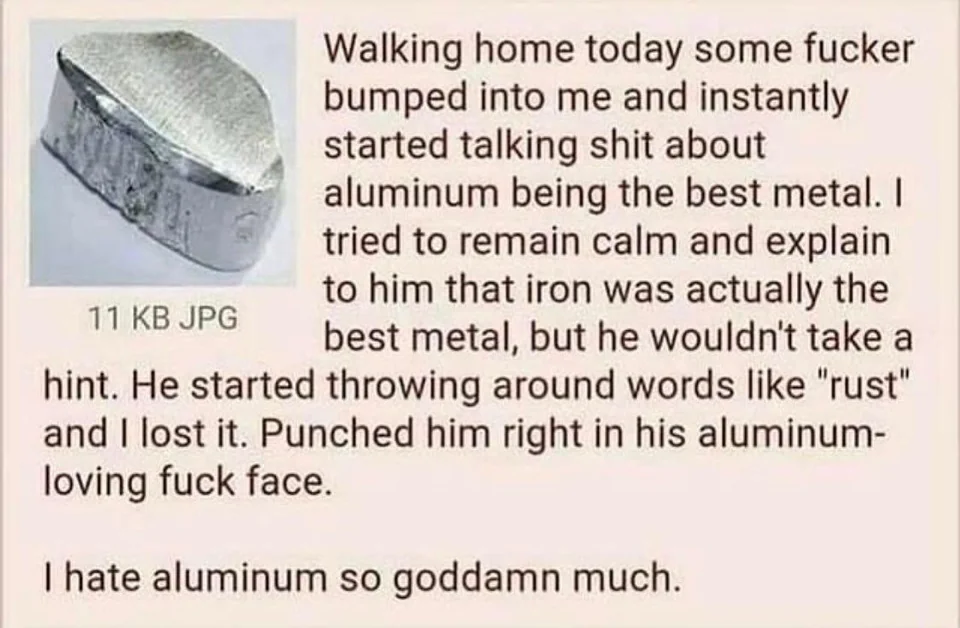this post was submitted on 08 Aug 2024
752 points (96.5% liked)
Science Memes
11970 readers
2317 users here now
Welcome to c/science_memes @ Mander.xyz!
A place for majestic STEMLORD peacocking, as well as memes about the realities of working in a lab.

Rules
- Don't throw mud. Behave like an intellectual and remember the human.
- Keep it rooted (on topic).
- No spam.
- Infographics welcome, get schooled.
This is a science community. We use the Dawkins definition of meme.
Research Committee
Other Mander Communities
Science and Research
Biology and Life Sciences
- [email protected]
- [email protected]
- [email protected]
- [email protected]
- [email protected]
- [email protected]
- [email protected]
- [email protected]
- [email protected]
- [email protected]
- [email protected]
- [email protected]
- [email protected]
- [email protected]
- [email protected]
- [email protected]
- [email protected]
- [email protected]
- [email protected]
- [email protected]
- [email protected]
- [email protected]
- [email protected]
- [email protected]
- !reptiles and [email protected]
Physical Sciences
- [email protected]
- [email protected]
- [email protected]
- [email protected]
- [email protected]
- [email protected]
- [email protected]
- [email protected]
- [email protected]
Humanities and Social Sciences
Practical and Applied Sciences
- !exercise-and [email protected]
- [email protected]
- !self [email protected]
- [email protected]
- [email protected]
- [email protected]
Memes
Miscellaneous
founded 2 years ago
MODERATORS
you are viewing a single comment's thread
view the rest of the comments
view the rest of the comments

As a former cyclist, steel is real. I’ve seen aluminum bikes fail (as in, break at the top and down tube)during a ride. Screw your aluminum!
...my steel frame split at the welds fourty-five years ago; my bonded aluminum frame has ridden out building fires with nary an issue...
having no fatigue limit is a bitch.
While I agree, I do have to clarify that there is a fatigue limit, it's mainly that the limit for steel increases so fast that few people are willing to put in the testing for billions of cycles to model ultra-high cycle fatigue
Where is that limit supposed to be? The line does not flatten, unlike that of steel. Which is a flat line from 1 million to 1 billion cycles. During the same number of cycles, aluminium drops from 25 to 14 ski, a loss of 44 %. The article specifically mentions:
Head's up, referring to it as a "limit" like your article did is incorrect. In engineering you have what's called an S-N diagram, which plots out the average time to failure based on average cyclic stress. Basically, a lower avaerage stress results in a higher average life. Also, this plot uses a logarithmic scale for both axis, because then all of the plots are straight lines.
For steel, the S-N diagram has what's called the "knee", which is where you have two distinct lines in the S-N curve: one horizontal and one at an angle, with the two intersecting at 1 million cycles. Referring to the knee as a limit (like in the article) is wrong because it's not a limit; it's the threshold where if you design a part to last beyond that (aka less cyclic stress than would get 1 million cycles) then it practically lasts forever.
In reality, the part won't actually last forever, since the S-N curve beyond 1 million cycles isn't perfectly horizontal. It's just that reducing your cyclic stress quickly increases your predicted life into billions or even trillions of cycles. This is known as ultra-high cycle fatigue, and it's generally impractical to do all the testing required to model because each sample would take months to test on the low end. Plus, there's little demand for such models in the industry, though there are a handful of PhD students and post-docs working on it
Does that change anything regarding the discussion? If the limit is quickly so high that it is beyond reasonable time spans? In the comparison at hand, aluminium has no fatigue limit, steel does. They still use aluminium for aircraft etc. due to the superior weight savings.
Yes, because the term "fatigue limit" makes lay people think the exact opposite of what is intended.
Aluminium doesn't get stronger on the welds like steel does, it gets weaker. So if you screw them up, you end up with a two part bike
Weaker or more brittle?
Weaker, by like 50%. Welding aluminium isn't worth it most of the time, just use steel if you need that. Otherwise bolt it together.
not to defend Alluminium (bleh), but that's likely a production error, bad hydroforming, bad welds... at least it's not CF!
It was the early 90’s and Raleigh had a line called Technium. The tubes were bonded to the lugs. Not really welded. More pinned and “glued” I guess. The frame broke at either the top or down tube and there went the fork, and my buddy’s face. Screw aluminum. Steel has memory. I found that out the hard way. I’m far from a metallurgist. This is the extent of my elementary teacher brain. And a broken cf seat post is scary.
I love my steel bike, it's great on the road, on gravel or for a quick grocery shop.
I'm not gonna win any competition with it but it is honestly such a fun bike.
And with care it should last forever.
And now I'm back to looking at steel (and titanium) adventure hardtails...